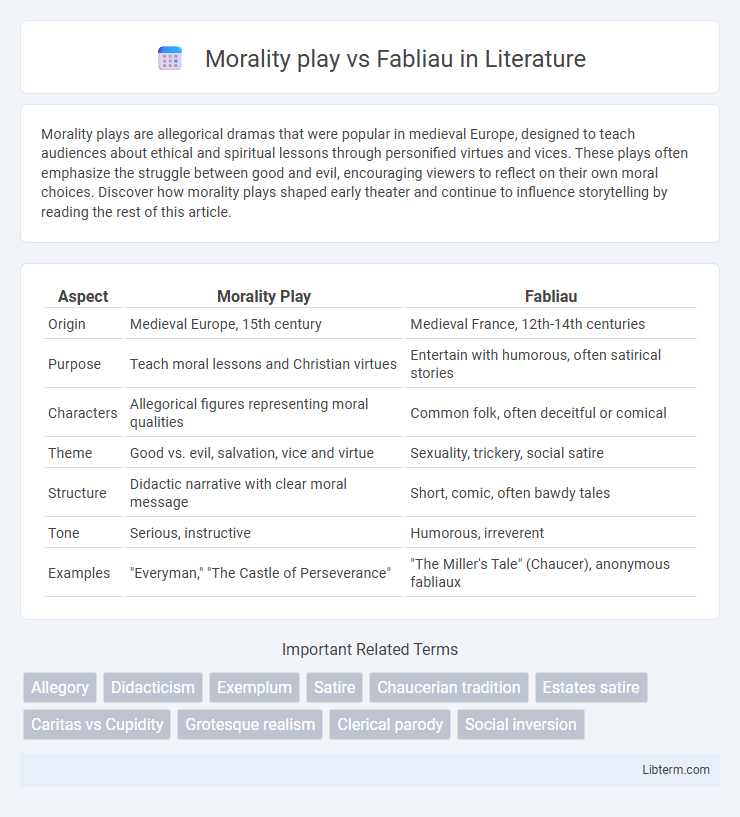Morality plays are allegorical dramas that were popular in medieval Europe, designed to teach audiences about ethical and spiritual lessons through personified virtues and vices. These plays often emphasize the struggle between good and evil, encouraging viewers to reflect on their own moral choices. Discover how morality plays shaped early theater and continue to influence storytelling by reading the rest of this article.
Table of Comparison
| Aspect | Morality Play | Fabliau |
|---|---|---|
| Origin | Medieval Europe, 15th century | Medieval France, 12th-14th centuries |
| Purpose | Teach moral lessons and Christian virtues | Entertain with humorous, often satirical stories |
| Characters | Allegorical figures representing moral qualities | Common folk, often deceitful or comical |
| Theme | Good vs. evil, salvation, vice and virtue | Sexuality, trickery, social satire |
| Structure | Didactic narrative with clear moral message | Short, comic, often bawdy tales |
| Tone | Serious, instructive | Humorous, irreverent |
| Examples | "Everyman," "The Castle of Perseverance" | "The Miller's Tale" (Chaucer), anonymous fabliaux |
Introduction to Morality Plays and Fabliaux
Morality plays, emerging in the late medieval period, are allegorical dramas designed to teach ethical lessons by personifying virtues and vices, often emphasizing the conflict between good and evil to guide audience behavior. Fabliaux, by contrast, are short, comic, and often ribald tales rooted in French medieval literature, focusing on satirical and humorous narratives that expose human folly and social norms through witty characters and plots. Both genres reflect distinct medieval cultural values, with morality plays reinforcing spiritual instruction and fabliaux highlighting secular, often cynical, social commentary.
Historical Background and Origins
Morality plays originated in the late medieval period, particularly in 15th-century Europe, as allegorical dramas designed to teach Christian ethical principles and guide audiences toward virtuous living. Fabliaux emerged earlier in the 12th to 14th centuries, primarily in France, as short, comic, and often ribald tales that satirized human vices and social institutions through humorous and sometimes crude storytelling. While morality plays served a didactic purpose tied to church teachings, fabliaux offered secular entertainment reflecting everyday life and popular culture in medieval society.
Key Themes and Motifs
Morality plays center on the battle between good and evil, illustrating moral lessons through personified virtues and vices to promote ethical behavior. Fabliaux emphasize bawdy humor, satire, and the subversion of social norms, often highlighting human folly and cunning in everyday life. Both genres explore human nature, but morality plays advocate virtue, while fabliaux revel in vice and trickery.
Structure and Narrative Style
Morality plays employ a didactic structure with allegorical characters embodying virtues and vices to convey ethical lessons, often using straightforward, linear narratives. Fabliaux feature a loosely structured, episodic format with vivid, humorous, and often bawdy storytelling that highlights everyday characters and satirical themes. The narrative style of morality plays is formal and instructive, while fabliaux embrace colloquial language and playful, ironic tones.
Characterization in Morality Plays vs Fabliaux
Morality plays feature allegorical characters embodying virtues, vices, and moral qualities to teach ethical lessons, emphasizing symbolic characterization over individual depth. Fabliaux present characters as realistic, often humorous or vulgar figures, reflecting everyday life with sharp social satire and straightforward human flaws. This contrast highlights morality plays' didactic purpose through abstract personifications, whereas fabliaux rely on vivid, relatable characters for comic effect.
Moral Lessons vs Satirical Narratives
Morality plays primarily emphasize moral lessons, using allegorical characters to convey ethical dilemmas and virtues, guiding audiences toward righteous behavior. Fabliaux, in contrast, utilize satirical narratives filled with humor and irony to critique societal norms and human follies without explicit moral instruction. The stark difference lies in morality plays fostering clear ethical frameworks, while fabliaux challenge conventions through comedic and often subversive storytelling.
Language and Tone Differences
Morality plays employ formal, allegorical language that emphasizes moral lessons and ethical dilemmas, often utilizing solemn and didactic tones to instruct audiences. Fabliaux, conversely, feature colloquial, earthy language filled with wit and humor, exhibiting a playful and irreverent tone to entertain through satire and bawdy tales. The difference in tone and language reflects their divergent purposes: moral edification versus comedic amusement.
Audience and Social Function
Morality plays targeted predominantly middle-class urban audiences, aiming to instruct viewers on ethical conduct and religious virtues through allegorical characters representing moral qualities. Fabliaux catered mainly to lower-class and bourgeois audiences, providing comedic, often bawdy tales that satirized social norms and clerical corruption. While morality plays reinforced societal values and promoted moral reform, fabliaux functioned as entertainment that challenged authority and highlighted everyday human follies.
Influence on Later Literature
Morality plays, with their allegorical characters and ethical lessons, laid the foundation for the development of didactic literature and early drama, influencing Renaissance and Elizabethan playwrights like Shakespeare in exploring human virtue and vice. Fabliaux, characterized by their comedic, often satirical narratives focused on everyday life and folly, impacted the evolution of European comic genres, inspiring later works such as Chaucer's "Canterbury Tales" and the rise of realist storytelling in prose. The distinct narrative techniques and thematic content of morality plays and fabliaux collectively shaped the diversity of medieval literature, contributing to the richness of Western literary tradition.
Lasting Legacy and Modern Relevance
Morality plays, with their enduring influence on ethical storytelling, laid the groundwork for modern drama by embedding universal moral lessons in theatrical form, shaping contemporary narratives focused on virtue and vice. Fabliaux, characterized by their satirical humor and earthy tales, persist in modern literature and media through their raw exploration of human follies and social critique, inspiring comedic genres and character archetypes. The lasting legacy of morality plays and fabliaux is evident in today's cultural landscape, where moral conflicts and irreverent humor continue to resonate and reflect societal values.
Morality play Infographic

 libterm.com
libterm.com